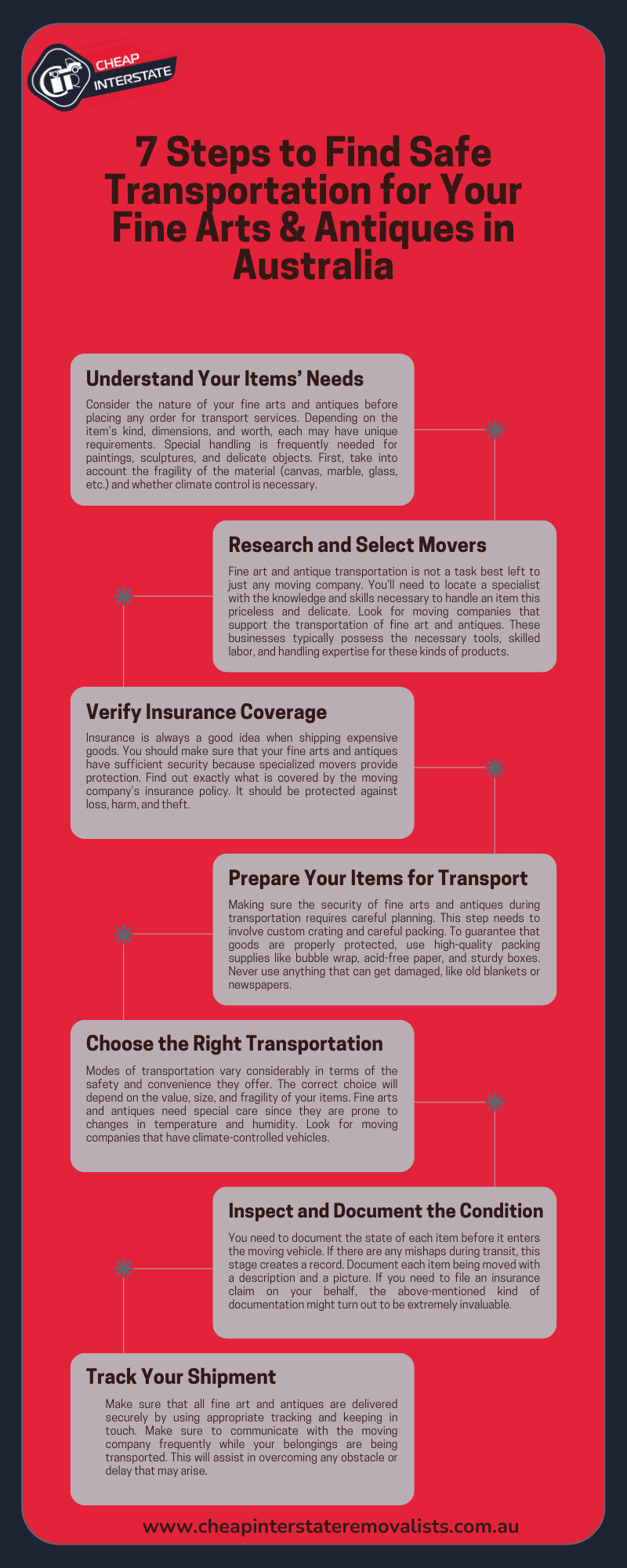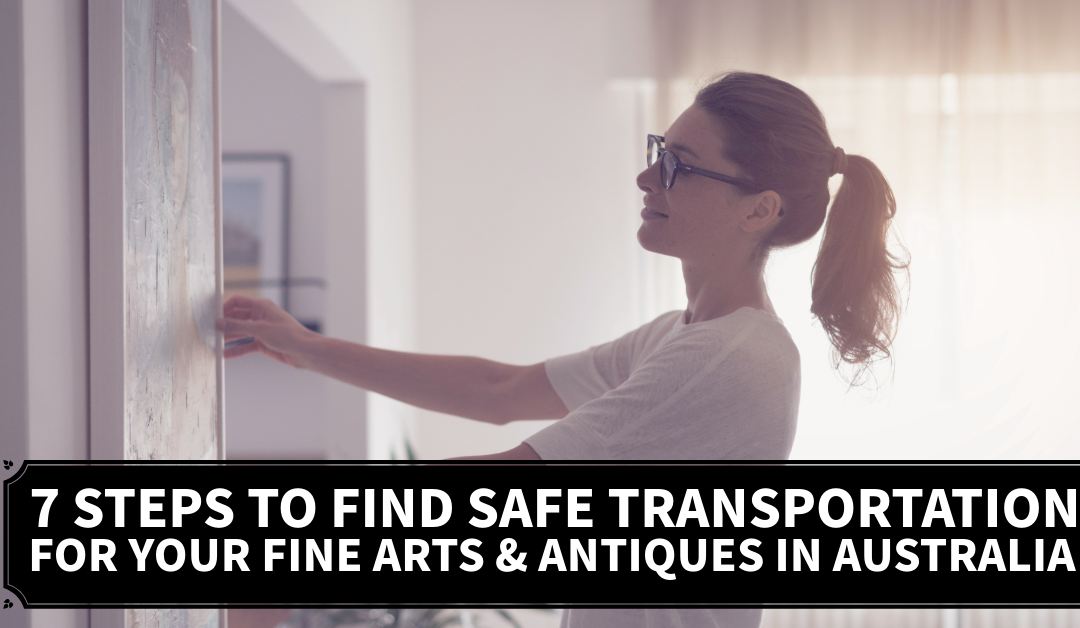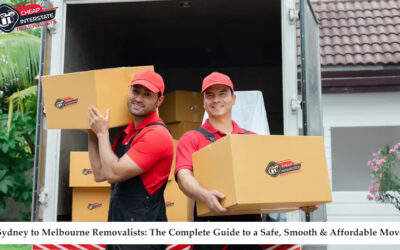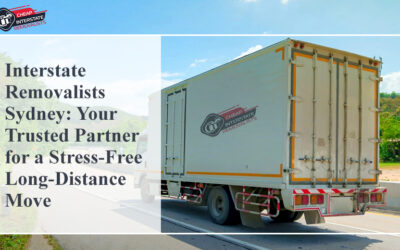Antiques and fine arts are the items that need to be transported with extra caution because they are extremely valuable and must arrive at their destination without damage. Whether moving across town or the nation, making the correct decisions is important. This is a thorough guide to securing transportation for your fine art and antiques throughout Australia:
1. Understand Your Items’ Needs
Consider the nature of your fine arts and antiques before placing any order for transport services. Depending on the item’s kind, dimensions, and worth, each may have unique requirements.
- Fine Arts: Special handling is frequently needed for paintings, sculptures, and delicate objects. First, take into account the fragility of the material (canvas, marble, glass, etc.) and whether climate control is necessary.
- Antiques: These items can be more fragile because of their significant age and historical value. Find out if your antiques need specific humidity and temperature, or if they need special padding or crating.
Make sure the transportation providers are aware of these needs and can meet them by having a clear understanding of them.
2. Research and Select Specialized Movers
Fine art and antique transportation is not a task best left to just any moving company. You’ll need to locate a specialist with the knowledge and skills necessary to handle an item this priceless and delicate.
- Find Specialized Movers: Look for moving companies that support the transportation of fine art and antiques. These businesses typically possess the necessary tools, skilled labor, and handling expertise for these kinds of products.
- Check Qualifications: Verify the movers’ credentials by looking up their accreditation from associations like the National Association of Antique Dealers or the Fine Art Shippers Association. These could be signs of professionalism and credibility.
3. Verify Insurance Coverage
Insurance is always a good idea when shipping expensive goods. You should make sure that your fine arts and antiques have sufficient security because specialized movers provide protection.
- Understand Coverage: Find out exactly what is covered by the moving company’s insurance policy. It should be protected against loss, harm, and theft.
- Consider Additional Insurance: To provide better coverage and peace of mind, highly valued items should be more insured with a reputable insurance company.
4. Prepare Your Items for Transport
Making sure the security of fine arts and antiques during transportation requires careful planning. This step needs to involve custom crating and careful packing.
- Packing Materials: To guarantee that goods are properly protected, use high-quality packing supplies like bubble wrap, acid-free paper, and sturdy boxes. Never use anything that can get damaged, like old blankets or newspapers.
- Custom Crating: Items that are exceptionally valuable or fragile may require custom crating. Occasionally available through specialist movers, this can also be scheduled with a qualified crating firm.
5. Choose the Right Transportation Method
Modes of transportation vary considerably in terms of the safety and convenience they offer. The correct choice will depend on the value, size, and fragility of your items.
- Climate-Controlled Vehicles: Fine arts and antiques need special care since they are prone to changes in temperature and humidity. Look for moving companies that have climate-controlled vehicles.
- Direct Routes: Look for direct routes that can be taken, when possible, to reduce transit time and handling. This reduces the risk of damage or loss.
6. Inspect and Document the Condition
You need to document the state of each item before it enters the moving vehicle. If there are any mishaps during transit, this stage creates a record.
- Detailed Inventory: Document each item being moved with a description and a picture. If you need to file an insurance claim on your behalf, the above-mentioned kind of documentation might turn out to be extremely invaluable.
- Condition Report: This should be completed by inspecting each item carefully for any previous damages and then noting them down. Ensure that the moving company gets access to this report to avoid problems and disputes in the future.
7. Communicate and Track Your Shipment
Make sure that all fine art and antiques are delivered securely by using appropriate tracking and keeping in touch.
- Stay in Touch: Make sure to communicate with the moving company frequently while your belongings are being transported. This will assist in overcoming any obstacle or delay that may arise.
- Track Your Shipment: If at all feasible, take advantage of any tracking services that the moving company may provide. In that scenario, you’ll always be able to find out where your shipment is.
Conclusion
It takes great planning and a good eye for detail to ensure that fine arts and antiques around Australia are moved safely. You will succeed in moving your items safely by knowing their needs, using specialized movers, checking for insurance coverage, preparing the items correctly, using the appropriate method of transportation, documenting their condition, and keeping open lines of communication.
This will not only safeguard your fine arts and antiques but also put your mind at rest throughout the process of transportation.
And if you are looking for reliable movers in Australia, employ Cheap Interstate Removalists In Australia. We are a team of the best and cheap removalists in Australia and have worked in this field for many years.
You can contact us through
mail at info@cheapinterstateremovalists.com.au
and can also call us on 0480 033 100.
If you want to grab the best deal of the season, then get a quote now.

Related Blogs
Sydney to Melbourne Removalists: The Complete Guide to a Safe, Smooth & Affordable Move
Sydney to Melbourne move is far from packing a truck and driving south. A long shift across two different cities with two different ways of living. Got almost 900 kilometres of highway. It needs a blend of real experience, actual move wins on this route, and honest...
Interstate Removalists Sydney: Your Trusted Partner for a Stress-Free Long-Distance Move
Your interstate move doesn’t begin when the truck arrives. It begins much earlier — at the moment you realise the next chapter of your life depends on how well the current one is wrapped up. The distance ahead isn’t just measured in kilometres. It’s measured in...
Trusted Interstate Removalists Melbourne for Safe and On-Time Relocations
Moving across states? You are not just hiring interstate removalists Melbourne, you are trusting someone with the long-haul, time and distance. A relocation with family to Sydney or your office to Canberra is a matter of care. An interstate move carries emotions,...

The Cheap Interstate Removalists Team boasts 5+ years of experience writing informative content about moving and packing. Our team of moving experts understands the hassles of relocating to Brisbane. Get helpful tips and advice for your move here. We are the #1 Removalists in Brisbane.




Recent Comments